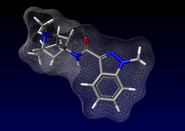Kytril
 |
|
 |
|
| Clinical data | |
|---|---|
| Trade names | Kytril, Sancuso, others |
| AHFS/Drugs.com | Monograph |
| MedlinePlus | a601211 |
| Pregnancy category |
|
| Routes of administration |
by mouth, intravenous, transdermal |
| ATC code | A04AA02 (WHO) |
| Legal status | |
| Legal status | |
| Pharmacokinetic data | |
| Bioavailability | 60% |
| Protein binding | 65% |
| Metabolism | Hepatic |
| Biological half-life | 3–14 hours |
| Excretion | Renal 11–12%, faecal 38% |
| Identifiers | |
|
|
| CAS Number |
109889-09-0 |
| PubChem (CID) | 3510 |
| IUPHAR/BPS |
2300 [3H]granisetron: 2292 |
| DrugBank |
DB00889 |
| ChemSpider |
10482033 |
| UNII |
WZG3J2MCOL |
| KEGG |
D04370 |
| ChEBI |
CHEBI:5537 |
| ChEMBL |
CHEMBL519643 |
| ECHA InfoCard | 100.212.327 |
| Chemical and physical data | |
| Formula | C18H24N4O |
| Molar mass | 312.41 g/mol |
| 3D model (Jmol) | Interactive image |
|
|
|
|
|
|
|
Granisetron is a serotonin 5-HT3 receptor antagonist used as an antiemetic to treat nausea and vomiting following chemotherapy. Its main effect is to reduce the activity of the vagus nerve, which is a nerve that activates the vomiting center in the medulla oblongata. It does not have much effect on vomiting due to motion sickness. This drug does not have any effect on dopamine receptors or muscarinic receptors.
Granisetron was developed by chemists working at the British drug company Beecham around 1988 and is available as a generic. It is produced by Roche Laboratories under the trade name Kytril. The drug was approved in the United Kingdom in 1991 and in United States in 1994 by the FDA.
A granisetron transdermal patch with the trade name Sancuso was approved by the US FDA on September 12, 2008. Sancuso is manufactured by 3M Drug Delivery Systems Division in St. Paul, MN, for ProStrakan, Inc., a pharmaceutical company headquartered in Bedminster, NJ, with global headquarters in Scotland.
Granisetron is metabolized slowly by the liver, giving it a longer than average half-life. One dose usually lasts 4 to 9 hours and is usually administered once or twice daily. This drug is removed from the body by the liver and kidneys.
It may be used for chemotherapy-induced nausea and vomiting and appears to work about the same as ondansetron. The most common side-effects of chemotherapy treatment are nausea, vomiting and diarrhea. This is one type of drug that a doctor can prescribe to prevent, lessen, or relieve discomfort.
...
Wikipedia
